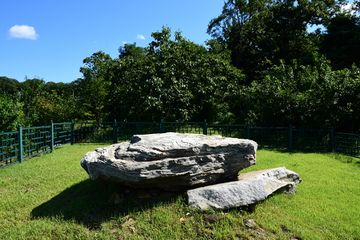"강화 대산리 지석묘"의 두 판 사이의 차이
(→영문) |
(→영문) |
||
| 31번째 줄: | 31번째 줄: | ||
A dolmen is a type of megalithic tomb constructed during the Bronze Age. Dolmens are found all over the world, but are notably concentrated in the Northeast Asian countries. Especially, with an estimated number of 40,000 to 45,000, dolmens in South and North Korea account for nearly 40% of the world’s total. Ganghwado Island contains a total of 127 dolmens, and 70 of them in comparatively better states were inscribed on the UNESCO World Heritage List in 2000, along with other dolmens in the Hwasun and Gochang areas in Jeolla-do. | A dolmen is a type of megalithic tomb constructed during the Bronze Age. Dolmens are found all over the world, but are notably concentrated in the Northeast Asian countries. Especially, with an estimated number of 40,000 to 45,000, dolmens in South and North Korea account for nearly 40% of the world’s total. Ganghwado Island contains a total of 127 dolmens, and 70 of them in comparatively better states were inscribed on the UNESCO World Heritage List in 2000, along with other dolmens in the Hwasun and Gochang areas in Jeolla-do. | ||
| − | This dolmen on the eastern slope of Goryeosan Mountain was | + | This dolmen, located on the eastern slope of Goryeosan Mountain, was a table type dolmen, though it is found collapsed. Table type dolmens are comprised of a wide, flat capstone stone supported by two upright stone slabs, forming a shape similar to that of a table. This dolmen is one of the largest among the those constructed in isolation in Ganghwa. Its capstone measures 3.68 m in length and 2.6 m in width. This dolmen is on the UNESCO World Heritage List. |
[[분류:인천광역시 문화유산]] | [[분류:인천광역시 문화유산]] | ||
[[분류:시도기념물]] | [[분류:시도기념물]] | ||
[[분류:지석묘]] | [[분류:지석묘]] | ||
2018년 8월 13일 (월) 10:24 판
| 강화 대산리 지석묘 Dolmen in Daesan-ri, Ganghwa |
|
| 대표명칭 | 강화 대산리 지석묘 |
|---|---|
| 영문명칭 | Dolmen in Daesan-ri, Ganghwa |
| 한자 | 江華 大山里 支石墓 |
| 주소 | 인천광역시 강화군 강화읍 대산리 1189 |
| 지정번호 | 인천광역시 기념물 제31호 |
| 지정일 | 1995.03.02 |
| 분류 | 유적건조물/무덤/무덤/지석묘 |
| 소유자 | 인천광역시 강화군청 |
| 수량/면적 | 1기 / 588㎡ |
|
|
|
해설문
국문
지석묘는 청동기 시대의 대표적인 무덤으로 고인돌이라고도 부르며, 주로 경제력이 있거나 정치권력을 가진 지배층의 무덤으로 알려져 있다. 우리나라의 고인돌은 4개의 받침돌을 세워 돌방을 만들고 그 위에 거대하고 평평한 덮개돌을 올려 놓은 탁자식과 땅속에 돌방을 만들고 작은 받침돌을 세운 뒤 그 위에 덮개돌을 올린 바둑판식으로 구분된다.
강화 고려산 동쪽 봉우리인 북산의 해발 약 20m 산등성이에 있는 이 고인돌은 탁자식이다. 약간의 흙과 자갈로 지면을 높이고 그 위에 받침돌을 세운 뒤 덮개돌을 올렸으나 현재는 무너져 내려앉았다. 덮개돌의 크기는 길이 3.68m, 너비 2.6m이다. 강화 지역에서 군을 이루지 않고 독립적으로 분포하고 있는 대형에 속하는 고인돌로 2000년 12월 2일 유네스코 세계문화유산으로 등록되었다.
영문
Dolmen in Daesan-ri, Ganghwa
A dolmen is a type of megalithic tomb constructed during the Bronze Age. Dolmens are found all over the world, but are notably concentrated in the Northeast Asian countries. Especially, with an estimated number of 40,000 to 45,000, dolmens in South and North Korea account for nearly 40% of the world’s total. Ganghwado Island contains a total of 127 dolmens, and 70 of them in comparatively better states were inscribed on the UNESCO World Heritage List in 2000, along with other dolmens in the Hwasun and Gochang areas in Jeolla-do.
This dolmen, located on the eastern slope of Goryeosan Mountain, was a table type dolmen, though it is found collapsed. Table type dolmens are comprised of a wide, flat capstone stone supported by two upright stone slabs, forming a shape similar to that of a table. This dolmen is one of the largest among the those constructed in isolation in Ganghwa. Its capstone measures 3.68 m in length and 2.6 m in width. This dolmen is on the UNESCO World Heritage List.
